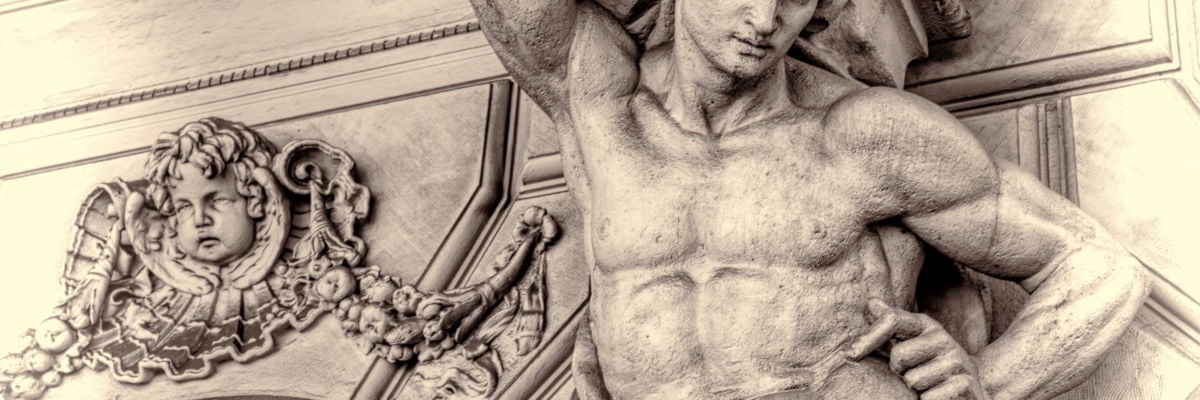
Throughout his voluminous writings, St. Augustine has constantly reminded us of a theological maxim ancient even in his time: man is made in the image and likeness of God. Of course, this is more than merely a maxim. It is a God-breathed fact, first made explicit in the early chapters of the Book of Genesis (1:26).
This first principle of Christian anthropology was fundamental to all of Augustine’s thought. He understood that it sets the context for all of salvation history, putting into proper perspective man’s original greatness, the gravity of sin, the significance of his redemption, and the glory of the heavenly life to come. Across his prolific corpus of writings there are more than eight hundred direct references to “the image and likeness of God” in his letters, sermons, and books.
What does it mean to be human? Augustine’s thought on this topic evolved dramatically over the course of his life. Before his Christian conversion, he was heavily influenced by the Manicheans, a heretical cult that held the soul to be good while demonizing the body. The Manicheans viewed the idea of the incarnation of God to be utter foolishness, as they could not conceive of why or how anything divine could subject itself to such condescension. In time, Augustine renounced the worldview of the Manicheans, referring to them in his Confessions as “a sect of men talking high-sounding nonsense, carnal and wordy men.”
As Augustine moved from Manichaeism to embrace Christianity, he came to embrace a positive theology of the body. Not only did his Christian anthropology deviate from that of his former Manichean stance, but it also departed from that of the ancient Greek philosopher Plato, who otherwise had an overall profound effect on Augustine’s thought throughout the latter’s life.
Plato believed that the human soul is trapped in the body, and the body is (here akin to the Manichean stance) a hindrance to be shed. True human freedom, therefore, involved the liberation of the soul from the body. Augustine did not accept this narrative. He understood that the body, though corrupted by sin, is inherently good. The Christian goal is not to renounce the body and the life proper to it, but rather to renounce sin and subordinate the body to the spirit—to what is reasonable and good.
Augustine knew the body’s original goodness. And with St. Paul and the tradition of the Church, he acknowledged that we are destined for resurrection and glorification of the body: “It is sown a physical body, it is raised a spiritual body” (1 Cor. 15:44). When the rational soul fully rules the body, the body becomes fully what it is meant to be as a human body.
Thus, Augustine teaches that the rational soul is what makes the human person like God. But, he is careful to point out, it is not right to think of the body as wholly separate from the soul’s powers. Augustine was not a dualist. He did not take the position (as did, say, René Descartes) that the soul and body are two distinct things interacting with each other. The soul is not the conductor or “engine” of the body. Rather, the body and the soul are one thing.
Since the human person is one integrated unity, human action becomes the physical outpouring of the rational spirit. As a triangle is not separate from its shape, the soul and body are one. As such, we can say that the soul infuses every aspect of the body.
St. Thomas Aquinas takes Augustine as his authority on this matter. In his Summa Theologiae, Thomas rebuts the notion that the soul functions as the motor of the body. He writes, “On the contrary, Augustine says, that ‘in each body the whole soul is in the whole body, and in each part is entire.’” In fact, we know this Augustinian principle to be true intuitively, for everyone understands without reflection that when we are punched anywhere in the body—whether in the arm or the foot or the ear—it is not only that part of us that is punched. If you punch a part of me, you punch me—and that is because (repeating Augustine) “in each body the whole soul is in the whole body, and in each part is entire.”
Furthermore, teaches Augustine, in our bodies we reveal our distinct humanness in rational actions like thought and prayer. The animals do not have an interior life—and any observation of even the highest animals bears no indication that they ponder the big questions as humans do. Augustine writes that, therefore, “the bodies of all animals, whether those that live in the water or those that live on land or those that fly around in the air, are bent forward to the earth, and do not have an upright posture like the human body.” Even our bodily postures become reflections of our humanity.
The great St. Ambrose was a “family friend” of Augustine and became a theological guide and mentor. He introduced Augustine to the concept of the incarnate Christ as the original image-bearer. Christ is the original eikon of God, writes Paul: “He is the image of the invisible God, the first-born of all creation” (Col. 1:15). Man, insofar as he imitates Christ, then, makes himself an exposition of the divine image. Theologian Gerald Boersma sums it up: “Christ is the image of God and the human person is the image of God inasmuch as he imitates Christ.”
But though it formed a part of his anthropology, this line of thought was not ultimately sufficient for Augustine. He insisted that there must be something inherent in man from the beginning, from the first moment of his existence at conception, that bears the divine image. As such, even the greatest sinner still deserves love and mercy, not because of what he has done, but because of what he is. Thus, Augustine concludes that the mind—or the “inner man”—is the common denominator that makes all human persons equally God-like.
In his great work on Trinitarian theology, De trinitate, Augustine reflects upon how man’s life of the mind emulates the inner life of the Trinity. There are three elements that characterize every act of the mind, he proposes
- the object of thought, which can be external (e.g., a tree) or internal (e.g., a memory);
- the faculty of the mind, which “receives” the object or is activated and formed by the object; and
- the voluntary or “intentional” element, whereby we direct our mind toward its object.
Augustine teaches that these three elements are present in all our cognitive acts, from sense to perception to contemplation. But it is specifically these three elements in the act of contemplation that images God in us. When we exercise self-knowledge and enter into our interior life, we bend ourselves reflexively “into ourselves” and manifest a cognitive unity reminiscent of the inner life of the Blessed Trinity. For it is God alone who contemplates himself in love, and who finds in that divine self-contemplation perfect happiness.
Here, one cannot help but remember the famous Delphic maxim described by Plato, which commands us to “know thyself.” Indeed, it is our interior life that makes us human. But Augustine teaches us that we are more than our minds. We are more than our bodies. We are persons. If we are to understand what it means to be made in the image and likeness of God, this we must not forget.



